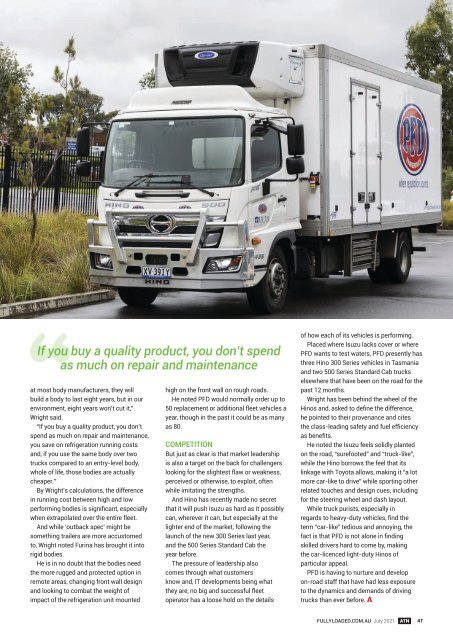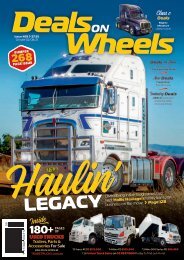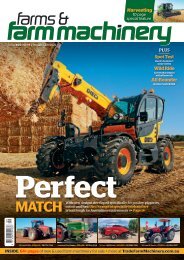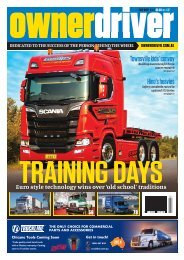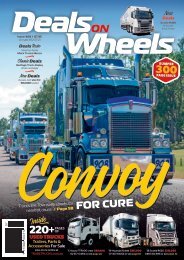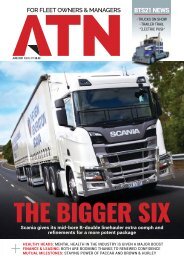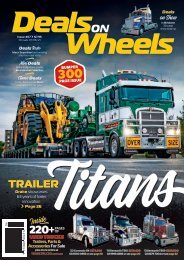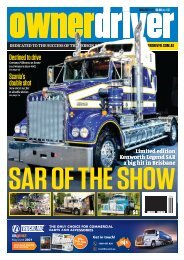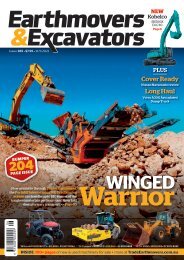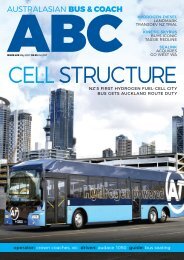You also want an ePaper? Increase the reach of your titles
YUMPU automatically turns print PDFs into web optimized ePapers that Google loves.
If you buy a quality product, you don’t spend<br />
as much on repair and maintenance<br />
at most body manufacturers, they will<br />
build a body to last eight years, but in our<br />
environment, eight years won’t cut it,”<br />
Wright said.<br />
“If you buy a quality product, you don’t<br />
spend as much on repair and maintenance,<br />
you save on refrigeration running costs<br />
and, if you use the same body over two<br />
trucks compared to an entry-level body,<br />
whole of life, those bodies are actually<br />
cheaper.”<br />
By Wright’s calculations, the difference<br />
in running cost between high and low<br />
performing bodies is significant, especially<br />
when extrapolated over the entire fleet.<br />
And while ‘outback spec’ might be<br />
something trailers are more accustomed<br />
to, Wright noted Furina has brought it into<br />
rigid bodies.<br />
He is in no doubt that the bodies need<br />
the more rugged and protected option in<br />
remote areas, changing front wall design<br />
and looking to combat the weight of<br />
impact of the refrigeration unit mounted<br />
high on the front wall on rough roads.<br />
He noted PFD would normally order up to<br />
50 replacement or additional fleet vehicles a<br />
year, though in the past it could be as many<br />
as 80.<br />
COMPETITION<br />
But just as clear is that market leadership<br />
is also a target on the back for challengers<br />
looking for the slightest flaw or weakness,<br />
perceived or otherwise, to exploit, often<br />
while imitating the strengths.<br />
And Hino has recently made no secret<br />
that it will push Isuzu as hard as it possibly<br />
can, wherever it can, but especially at the<br />
lighter end of the market, following the<br />
launch of the new 300 Series last year,<br />
and the 500 Series Standard Cab the<br />
year before.<br />
The pressure of leadership also<br />
comes through what customers<br />
know and, IT developments being what<br />
they are, no big and successful fleet<br />
operator has a loose hold on the details<br />
of how each of its vehicles is performing.<br />
Placed where Isuzu lacks cover or where<br />
PFD wants to test waters, PFD presently has<br />
three Hino 300 Series vehicles in Tasmania<br />
and two 500 Series Standard Cab trucks<br />
elsewhere that have been on the road for the<br />
past 12 months.<br />
Wright has been behind the wheel of the<br />
Hinos and, asked to define the difference,<br />
he pointed to their provenance and cites<br />
the class-leading safety and fuel efficiency<br />
as benefits.<br />
He noted the Isuzu feels solidly planted<br />
on the road, “surefooted” and “truck-like”,<br />
while the Hino borrows the feel that its<br />
linkage with Toyota allows, making it “a lot<br />
more car-like to drive” while sporting other<br />
related touches and design cues, including<br />
for the steering wheel and dash layout.<br />
While truck purists, especially in<br />
regards to heavy-duty vehicles, find the<br />
term “car-like” tedious and annoying, the<br />
fact is that PFD is not alone in finding<br />
skilled drivers hard to come by, making<br />
the car-licenced light-duty Hinos of<br />
particular appeal.<br />
PFD is having to nurture and develop<br />
on-road staff that have had less exposure<br />
to the dynamics and demands of driving<br />
trucks than ever before.<br />
FULLYLOADED.COM.AU July 2021 <strong>ATN</strong> 47


